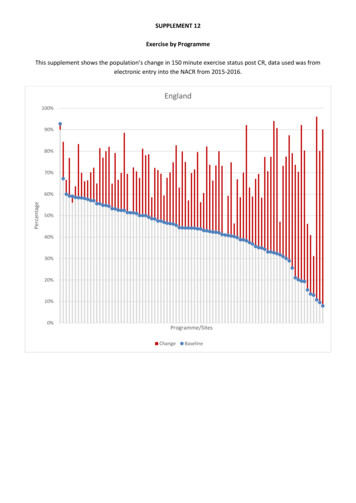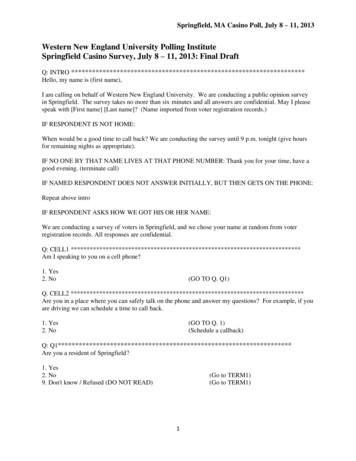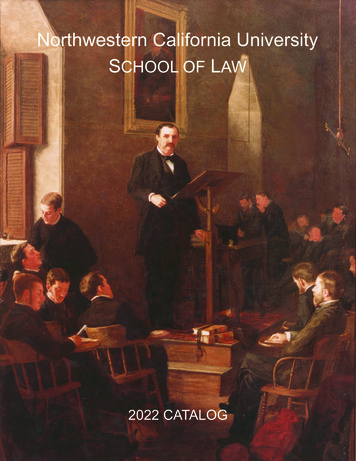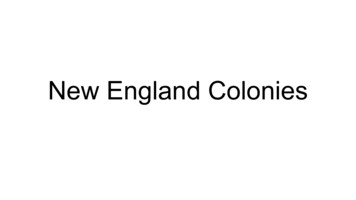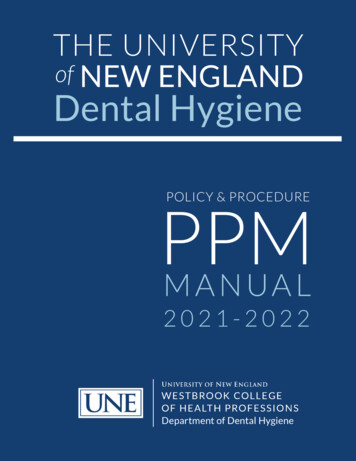
Transcription
THE UNIVERSITYof NEW ENGLANDDental HygienePOLICY & PROCEDUREPPMM A N UA L2021-2022
Dental Hygiene ProgramPolicy and ProceduresManual2021-2022Portland Campus716 Stevens AvenuePortland, Maine 04103(207)-221-4900
DENTAL HYGIENEPROGRAM POLICIES AND PROCEDURES MANUALMarji Harmer-Beem, R.D.H., M.S.UNE Dental Hygiene Program DirectorFaculty ContributorsMary Aube, R.D.H., M.S. EdAssociate Clinical ProfessorRuth Collard, R.D.H., B.S.Adjunct FacultyLisa Dufour, R.D.H., M.S.Professor EmeritusMarji Harmer-Beem, R.D.H., M.S.Associate ProfessorLaura Krause, D.D.S.Associate Clinical ProfessorBeverley Litchfield, R.D.H., D.H.Sc.Adjunct FacultyDanielle Peterson, R.D.H., MHA, EdDAssistant Clinical ProfessorRachael Salamon, R.D.H., M.S.D.H.Assistant Clinical FacultyCourtney Vannah, R.D.H., M.S.Assistant Clinical Professor
Table of ContentsDental Hygiene Program 838Dental Hygiene Vision & Core ValuesDental Hygiene Learning Outcomes and Program GoalsDental Hygiene Technical StandardsCompetenciesUNE Dental Hygiene Program Standards of Clinical PracticeAccreditationLicensureBachelor of Science Degree in Dental HygieneStudent ExpensesStudent American Dental Hygiene AssociationAmerican Dental Hygienists’ Association Code of Ethics for Dental HygienistsProfessionalismSocial MediaDental Hygiene Department Faculty and StaffDental Hygiene Faculty AdvisorsTutorial / Learning AssistanceStudent Access Center (Formally Office for Students with Disabilities)Student Attendance / Respectful Behaviors / AttireStudent MessagesGrading PoliciesProgram Probation and RemediationAcademic ProbationResolution of DifferencesAcademic Honesty & Testing PolicyAcademic and Disciplinary Appeals PolicyIncomplete Grading PolicySubstance Use and Abuse PolicyHealth Examination / ImmunizationsStudents with DisabilitiesSexual Harassment PolicyViolence in the Workplace PolicyCampus ParkingChildren on Campus PolicyPolicy on Visitors & ObserversUNE FacilitiesComplaints PolicyCourse Transferability NoticeHIPAADental Hygiene Professional Conduct ContractCPR CertificationFormative Evaluation PolicyAthletic Competition and Class AttendanceLocal Anesthesia Policy (Second Semester Seniors)
Safety Program2.1Introduction / Chemical Hygiene Plan2.2Transmission of Bloodborne Pathogen Diseases2.3Viral Hepatitis2.4HIV Infection2.5Vaccinations2.6Other Vaccines2.7Testing for TB2.8Personal Protective Equipment (PPE)2.9Standard Precautions2.10 Sterilization, Disinfection2.11 Sterilization Procedures2.12 Waste Management2.13 Biomedical Waste2.14 Sharps2.15 Infection Control Considerations2.16 Exposure Control Plan2.17 Exposure to Blood2.18 Occupational Exposure Referral2.19 Hospital Addresses2.20 Accident and Injury Policy2.21 Bloodborne Pathogen Standard2.22 Emergency and First Aid Equipment and Procedures2.23 Hazard Communication and Safety Program2.24 Definition of a Hazardous Material2.25 Health and Environmental Hazards Actions to Combinations2.26 Chronic Effect Codes, OSHA – Health Hazards2.27 Wilson’s RISK Scale of Material Hazards2.28 Identification of the Health Hazards of Materials2.29 Hazardous Materials Identification System2.30 Emergency Evacuation2.31 Responding to Fire Alarms2.32 Muster Locations2.33 Health and Safety Committee2.34 Accident & Injury Policy2.35 Infection Prevention Checklist2.36 Quality Assurance Policy2.37 Radiographs and Radiographic 51525253535455565757575858585858Clinic Protocol and Evaluation Process3.1 General Guidelines for Dental Hygiene Students3.2 Attendance Policy3.3 Clinical Evaluation and Assessment of Student Learning3.3.1 Radiographic Policies & Procedures for Clinical Sessions3.4 Grading Rubric and Web-Based Grading3.4.1 Interpfrofessional Competencies3.5 Clinical Performance6061626263666767
3.323.333.34Clinical RequirementsPatience Care CompetenciesCommunity Involvement and Health Promotion and Disease PreventionBroken Instrument Policy and ProcedureChild Abuse PolicyLatex Allergies PolicyPolicy for Patient RecordsReferral Form Policy and ProcedureSealant PolicyFees for Dental Hygiene ServicesIndices and Classification SystemsPeriodontal Screening Record (PSR)Plaque Index – Patient Hygiene Performance (PHP)Stages and Grades of Periodontal InvolvementPatient Classification for DepositClassification of CariesMiller Classification of Gingival RecessionStudent Clinical DutiesGuidelines for Patients Treatment SequenceInformed ConsentLocal Anesthesia ConsentExpectations for the Mentor / InstructorFaculty TrainingPerformance Criteria for Assessing Patient Care CompetenciesClinician Medication PolicyUNE Dental Hygiene Program Standards for Care (see 1.5)Program, Clinic and Lab AttireRisk AssessmentPeriodontal Treatment ProtocolMedical Considerations for Patient Care4.1 Patient Medical History Complications ProcedureASA’s Physical Status Classification System4.2 Diseases with Significant Oral Care PrecautionsI.Cardiovascular DiseasesII.Bloodborne PathogensIII.Hematologic DisordersIV.Respiratory TractV.Endocrine DisordersVI.Musculoskeletal ConditionsVII.Highly Contagious Infections4.3 Medical Emergency Risk Management4.4 Medical Emergency Plan of Action Protocol4.5 Emergency ProceduresI.Vasodepressor SyncopeII.Airway ObstructionIII.Cardiac 5105105106
RespiratoryCerebrovascular AccidentAngina PectorisMyocardial InfarctionAnaphylaxisDiabetes Mellitus Hypoglycemia Shock / ComaContact ntilationBurnsForeign Body in Eye106106107107107108109109109110110111111111
APPENDICESI.Recommendation for Prevention of Bacterial Endocarditis1. AHA Endocarditis Prophylaxis Recommendations on Antibiotic Choice,dosage and Regiman,2. Recommended Condition for Use of Antibiotic Prophylaxis3. Orthopedic Implants4. Breast ImplantsII.III.IV.113Management of Hypertensive Patient1. Follow-up and Treatment Recommendations2. Management of the Hypertensive Patient3. Reduction of Stress and AnxietyBlood Chemistry1. Tests Used for Blood Evaluation2. International Normalized Ratio (INR)3. Normal White Blood Cell CountDocuments for Clinical Procedures and Patient Care1. UNE Accident / Incident Report Form2. Blood & Body Fluid Exposure Protocol3. Exposure to Blood Flowchart4. Exposure Consent Form5. HIV Pre-Test Counseling Procedures6. HIV Post-Test Counseling Procedures7. Dental Hygiene Program Statement of Services8. Patient Appointment Statement9. Clinic Registration Form10. Patient’s Rights and Responsibilities11. Local Anesthesia Consent12. Radiographic / Fluoride TreatmentRecommendations13. Previsor14. Patient Referral Form15. Patient Contact Information16. Medical History17. Patient Clinical Notes18. Dental Chart19. Periodontal Chart20. Infection Control Manager I21. Infection Control Manager II22. Infection Control Manager III23. Commonly Used Clinical Codes24. Clinic Fees25. Individual Blood Glucose Test Values26. TalEval Evaluation Forms27. Drug Screening Questionnaire (DAST)28. NIDA29. COVID-19 Screening 160162164165166167168174177183
DENTAL HYGIENEPROGRAM POLICIES1
1.1 Dental Hygiene Mission, Vision and Core ValuesMissionThe Dental Hygiene Program endeavors for excellence by preparing oral health professionals intellectuallyand practically for a broad and robust career in dental hygiene.VisionIn the context of the University of New England’s Vision, the dental hygiene program aspires to be anational leader in dental hygiene education by offering opportunities that are student centered andinterprofessional and endeavors to be authentic and professional in all relationships. The program will giveour students a broad and diverse experience.Core ValuesThe Dental Hygiene Program has identified a set of core values that set the tenor of what the program doesand guides our daily interactions: Student CenterednessThe dental hygiene program puts students learning, aspirations, needs and success at the center of what wedo to exemplify academic excellence. Critical ThinkingCritical thinking is fundamental to problem solving, implementing the dental hygiene process of care, andethical decision making. Therefore, critical thinking is focal to learning the profession of dental hygiene andapplying evidenced-based care to all people. Experiential LearningLearning by doing in a real-world environment is exciting and engaging for the student. The Dental HygieneProgram is committed to providing the most dynamic learning possible by being part of inter andinterprofessional health care teams. Interprofessional EducationThe dental hygiene program supports and participates in IPE. We believe IPE serves to give students andfaculty experiences in collaboration, teamwork and inclusion. Lifelong LearningLearning throughout life is paramount for keeping pace with the ever-changing world of technology, healthcare and one’s understanding of the world we live in for civic, personal, social or employment aims. Professional and Ethical BehaviorUsing guides and codes to mentor students and demonstrate professional behaviors, faculty are authentic,kind, respectful and honest in all interactions. We believe teaching and learning by example builds integritywithin the Program.The core values listed above guide the work of faculty and supportive professional staff in our interactionwith students and give our decision-making meaning.2
1.2 Dental Hygiene Learning Outcomes and Program GoalsLearning OutcomesThe Dental Hygiene Program faculty will immerse students in educational experiences that prepares thestudent to achieve the following learning outcomes:1. Provide the public with compassionate and competent dental hygiene care founded on evidencedbased scientific knowledge as an essential component of comprehensive interprofessional health careand community-based health care.2. Demonstrate effective decision-making skills through the use of the critical thinking process.3. Explore the complexities of ethical decision-making as it relates to professional expectations andsocial responsibility.4. Commit to leadership, scholarship, and life-long learning to respond to an ever-changing healthcareenvironment and growing profession.5. Utilize oral healthcare technology (Health Informatics) to enhance patient care and communicationabilities in the professional and practical arenas.6. Successfully gain access to dental hygiene licensure in the state of choice by completing the nationaland regional board examinations.Faculty will participate in leadership and scholarship with the vision of national engagement as anoverarching goal.The Dental Hygiene Program GoalsThe dental hygiene program strives to:1. Be a national leader in dental hygiene education.2. Offer opportunities to students that are student centered, interprofessional, leadership forward, anddiversely experiential in clinical and community settings.3. Be authentically honest and professional in all relationships.3
1.3 Technical StandardsIntroductionTechnical standards are the nonacademic functional abilities that are essential for thedelivery of effective and safe dental hygiene care. The technical standards listed belowidentify the skills and behaviors necessary to successfully complete the dental hygienecurriculum and adequately prepare our students for the practice of dental hygiene.Technical standards review is conducted annually for students.The Dental Hygiene Program’s technical standards are as follows, which a student must meet withor without reasonable accommodations:Motor Skills / Manual DexterityStudents must have full manual dexterity including adequate functioning of arms, wrists, hands andfingers. Appropriate psychomotor skills, manual dexterity and motor movement skills are necessaryto render clinical dental hygiene treatment while possessing the physical strength to move oneselfinto a position that will enable the student to provide appropriate dental hygiene care.The student must be able to: Use personal protective devices (tolerate face mask/shield, safety eyewear, surgical gloves andlaboratory coat). Function in an environment where latex is present.Carry out OSHA infection control procedures using cleaners and chemicals.Perform dental hygiene procedures (scaling, polishing, x-rays) and manipulate dental materialsAccess a patient from a seated or standing position.Operate switches, knobs, levers in operation of the dental chair and accessory equipment in allclinics and laboratory settings.Exhibit sufficient motor function to elicit information from a patient by palpation, auscultation,percussion, and other diagnostic modalities.Perceive and interpret tactile vibrations appropriately.Manipulate small objects and materials, paying close attention to fine detail.Perform basic life support including CPR.Transfer and position patients with disabilities. Sensory Skills / Observation SkillsA functional use of all senses is required. Visual acuity and intellectual ability are necessary to acquireinformation from documents such as charts, radiographs, small print, handwritten notations andcomputer images. Appropriate depth perception with vision from a distance of 18” with or withoutcorrective lenses is essential.A student must be able to: Observe demonstrations at a distance and close at hand.4
Perform procedures in the classroom, clinic area and laboratory setting.See fine detail, focus at several distances, discern variations in color, shape and texture in orderto differentiate abnormal from normal.Discern tactile sensations to perceive and interpret information associated with clinicprocedures visually assess, bimanually palpate hard and soft anatomic structures.Develop reasonable skills of percussion and auscultation.Intellectual Skills / Conceptual and Cognitive SkillsConsistent, accurate and quick integration of information is required especially in an emergencysituation.The student must: Possess the ability to learn, interpret, integrate, analyze and synthesize dataPossess the intellectual abilities required to carry out reasoning, analysis, problem – solving,critical thinking, self-evaluation and lifelong learningBe able to comprehend three dimensional and spatial relationshipsCommunication SkillsA student must: Communicate effectively with patients, colleagues, faculty and guests in verbal, nonverbal, andwritten form.Possess sufficient command of the English language in order to retrieve information fromlectures, textbooks, and exams.Be able to obtain an accurate medical/dental history.Be able to accurately record findings in patients’ records.Technological Skills A Student must: Be able to maintain Electronic Health Record (EMR/HER) Navigate Web-based management electronic systems for patient disease risk management,student grading, and communication. Be proficient with word processing software.Behavioral / Social / Mental / Emotional SkillsHigh levels of emotional and mental stability are required on a daily basis.A student must: Demonstrate Emotional Intelligence.Demonstrate respect and caring for patients, peers, staff, and faculty.Interact with peers, patients, staff and faculty in an emotionally stable, professional, and ethicalmanner.Demonstrate respect for the diversity of cultures among clinical patients, college personnel andpeers.5
Demonstrate a team approach in carrying out responsibilities in all settings.Endure physically taxing workloads.Function effectively under stress.Adapt to changing environments by displaying flexibility.Display compassion, integrity, concern for others, respect, strong interpersonal skills.Be tactful and congenial.Be able to accept criticism and respond by appropriate modification of behavior. Beable to interrelate among colleagues, staff, and patients with honesty, integrity,professionalism and nondiscrimination.Exercise good judgment.Promptly complete responsibilities attendant to the diagnosis and care of patients, and thedevelopment of mature, sensitive, and effective relationships with patients.Respect the confidentiality of patient privacy.Other SkillsStudents must demonstrate the ability to arrive at their clinical assignments on time and meetthe programmatic requirements in a timely, professional and competent manner.Students will be required to sign a document to attest that with proper training there would be noreason why the student would not be capable of performing the technical standards expected of astudent in the UNE Dental Hygiene Program as outlined above, with or without reasonableaccommodations.AccreditationThe University of New England is accredited by the New England Association of Schools and Colleges,Inc., which accredits schools and colleges in six New England states. The Commission on DentalAccreditation accredits the Dental Hygiene Program.ProfessionalismProfessionalism is inherent to the practice of dental hygiene. The public has an expectation of whatthe dental hygienist’s behavior should be, and therefore it is reasonable that the dental hygienistwould behave in such a manner and conform to technical and ethical standards of the dental hygieneprofession. Professionalism, generally, is defined as exhibiting a courteous, conscientious, andbusinesslike manner to all patients, peers and faculty. Other characteristics of the professional dentalhygienist are being clean, neat, health and prevention orientated, detail conscious, and motivated byservice. It is important to realize that professionalism is a mandatory skill that is continually evaluatedduring your time here as a student (see section 3.28 of the Dental Hygiene Program Policy &Procedures Manual).6
1.4 CompetenciesPROFESSIONALISM AND ETHICS1. Apply a professional code of ethics in all endeavors.2. Adhere to state and federal laws, recommendations and regulations in the provision of dental hygienecare.3. Provide dental hygiene care to promote patient/client health and wellness using critical thinking andproblem solving in the provision of evidence-based practice.4. Assume responsibility for dental hygiene actions and care based on accepted scientific theories andresearch as well as the accepted standard of care.5. Continuously perform self-assessment for life-long learning and professional growth.6. Advance the profession through service activities and affiliations with professional organizations.7. Provide quality assurance mechanisms for health services.8. Communicate effectively with individuals and groups from diverse populations both in writing andverbally.9. Provide accurate, consistent and complete documentation for assessment, diagnosis, planning,implementation and evaluation of dental hygiene services.10. Provide care to all patients using an individualized approach that is humane, empathetic, andcaring.11. Pursue continuing education courses and/or higher education that demonstrate a commitmentto lifelong learning.COMMUNITY INVOLVEMENT1.2.3.4.Provide community oral health services in a variety of settings.Provide screening, referral and education services that facilitate public access to the health care system.Respond to patient or community requests for information about contemporary dental problems.Promote the dental hygiene profession by actively participating in the membership, leadership and / orservice in professional organizations.5. Assess and evaluate community based oral disease prevention strategies that aim to improve the oralhealth of the public.HEALTH PROMOTION AND DISEASE PREVENTION1. Evaluate and utilize methods to ensure the health and safety of the patient and the dental hygienist inthe delivery of dental hygiene.2. Evaluate factors that can be used to promote patient adherence to disease prevention and/or healthmaintenance strategies.3. Provide educational methods using appropriate communication skills and educational strategies topromote optimal health.4. Promote preventive health behaviors by personally striving to maintain oral and general health.5. Identify individual and population risk factors and develop strategies that promote health related qualityof life.7
PATIENT CARE1. Assessmenta. perform a comprehensive examination using clinical, radiographic, periodontal, dental charting, andother data collection procedures to assess the patient's needsb. Recognize predisposing and etiologic risk factors that require intervention to prevent diseasec. Obtain, review and update a complete medical and dental historyd. Recognize health conditions and medications that impact overall patient caree. Identify patients at risk for a medical emergency and manage the patient in a manner that preventsan emergency2. Diagnosisa. Use assessment findings, etiologic factors and clinical data in determining a dental hygiene diagnosisb. Identify patient needs and significant findings that impact the delivery of dental hygiene servicesc. Obtain the proper consultations as indicated3. Planninga. Establish a planned sequence of care based on the dental hygiene diagnosis; identified oral conditions;potential problems; etiologic and risk factors; and available treatment modalitiesb. Prioritize the care plan based on the health status and actual and potential problems of the individual tofacilitate optimal healthc. Establish a collaborative relationship with the patient in the planned care to include the etiology,prognosis, and treatment alternativesd. Make referrals to other health care professionalse. Obtain the patient's informed consent4. Implementationa. Utilize accepted infection control proceduresb. Obtain diagnostic quality radiographsc. Apply basic and advanced techniques of dental hygiene instrumentation to remove deposits withouttrauma to hard and soft tissuesd. select and administer appropriate chemotherapeutic agents and provide pre and post treatmentinstructionse. provide adjunct dental hygiene services that are legally permittedf. Provide oral health education to assist patients in assuming responsibility for their own oral health5. Evaluationa. Evaluate the effectiveness of the patient's self-care and the dental hygiene treatment in attaining ormaintaining oral healthb. Determine the clinical outcomes of dental hygiene interventionsc. Develop a maintenance program that meets the patient's needsd. Provide referrals for subsequent treatment based on the evaluation findings* Patient care and community-centered competencies also appear in sections 3.07 and 3.08.8
1.5 UNE Dental Hygiene Program Standards of Clinical PracticeThe Standards for Clinical Dental Hygiene Practice are a resource for dental hygiene practitionersseeking to provide patient-centered and evidence-based care.Standard 1: AssessmentThe collection and analysis of systematic and oral health data in order to identify client needs.1. HEALTH HISTORY: Data on health status are comprehensive and include information on thepatients’ general health, oral health, and behavioral patterns.Demographic InformationVital SignsPhysical CharacteristicsSocial historyMedical historyPharmacologic history2. CLINICAL ASSESSMENT: Planning and providing optimal care require a thorough andsystematic overall observation and clinical assessment.Examination of the head and neck and oral cavity, including oral cancer screening.Complete, and diagnostic set of radiographs.A comprehensive periodontal examinationA comprehensive hard-tissue evaluation.3. RISK ASSESSMENT: Qualitative and quantitative evaluation based on health history and clinicalassessment to identify any risks to general and oral health. Factors that should be evaluated todetermine level of risk (high, moderate, low) include but are not limited to:Fluoride exposure, tobacco exposureNutrition historySystemic disease/conditionsPrescriptions/over the counter drugsSalivary functionAge, gender, genetics and family historyHabit and lifestyle behaviorsPhysical disabilityPsychological, cognitive, and social considerationsStandard 2: Dental Hygiene DiagnosisThe identification of an individual’s health behaviors, attitudes, and oral health care needs for which adental hygienist is educationally qualified and licensed to provide. The dental hygiene diagnosis providesthe basis for the dental hygiene care plan.I.Analyze and interpret all assessment data.II.Formulate the dental hygiene diagnosis or diagnoses.III.Communicate the dental hygiene diagnosis with patients or clients.IV.Determine patient needs that can be improved through the delivery of dental hygienecare.9
V.Identify referrals needed within dentistry and other health care disciplines based ondental hygiene diagnoses.https://www.adha.org/resources-docs/7111 Dental Hygiene Diagnosis Position Paper.pdfStandard 3: PlanningPlanning is the establishment of realistic goals and the selection of dental hygiene interventions that canmove the client closer to optimal oral health. The dental hygiene treatment plan is derived from the dentalhygiene diagnosis and includes goals, priorities, dental hygiene procedures and patient action.I.II.III.IV.V.VI.VII.Identify all needed dental hygiene interventions.In collaboration with the patient and/or caregiver prioritize and sequence theinterventions.Identify and coordinate resources needed to facilitate comprehensive qualitycare.Collaborate and work effectively with the dentist and other health careproviders and community based oral health care programs to provide highlevel, patient centered care.Present and document dental hygiene care plan to the patient/caregiver.Counsel and educate the patient/caregiver about the treatment rationale, risks,benefits, anticipated outcomes, evidence-based treatment alternatives, andprognosis.Obtain and document informed consent and /or informed refusal.Standard 4: ImplementationThe act of carrying out the dental hygiene care. Care should be delivered in a manner that minimizesrisk; optimizes oral health; and recognizes issues related to patient comfort including pain, fear, and oranxiety.I.II.III.IV.V.VI.VII.VIII.IX.Review and confirm the dental hygiene care plan with the patient/caregiver.Modify the plan as necessary and obtain additional consent.Implement the plan beginning with the mutually agreed upon first prioritizedintervention.Monitor patient comfort.Provide any necessary post-treatment instruction.Implement the appropriate self-care intervention; adapt as necessary throughoutfuture interventions.Confirm the plan for continuing care or maintenance.Maintain patient privacy and confidentiality.Follow up as necessary with the patient (post treatment instruction, painmanagement, self-care)Standard 5: EvaluationEvaluation is the measurement of the extent to which the client has achieved the goals specified in the dentalhygiene care plan. The dental hygienist uses evidence-based decisions to continue, discontinue, or modifythe care plan based on the ongoing reassessments and subsequent diagnoses. Evaluation occurs throughout10
the process as well as at the completion of care.I.Use measurable assessment criteria to evaluate outcomes.II.Communicate to patient, dentist, and other health care providers the outcomes of dentalhygiene care.III.Evaluate patient satisfaction of the care provided through oral and writtenquestionnaires.IV.Collaborate to determine the need for additional diagnostics.V.Self-assess the effectiveness of the process of providing care, identifying strengths andareas for improvement.Standard 6: DocumentationThe primary goals of good documentation are to maintain continuity of care, provide a means ofcommunication and to minimize the risk of exposure to malpractice claims.I.II.III.IV.V.VI.Document all components of the dental hygiene process of care (assessment,dental hygiene diagnosis, planning, implementation and evaluation) includingpurpose of the patient’s visit in the patient’s own words.Objectively record all information and interactions between the patient and thepractice. (phone calls emergencies, failure to return for treatment, follow through)Record legible, concise and accurate information. (dates and signatures)Recognize ethical and legal responsibilities of recordkeeping including guidelinesoutlined in state regulations and statutes.Ensure compliance with HIPPA.Respect and protect the confidentiality of patient information.Resource: Adapted from the American Dental Hygienist Association Standards of Applied Dental Hygiene PracticeRetrieved August 2, 2018, .6 AccreditationThe University of New England is accredited by the New England Association of Schools and Colleges,Inc., which accredits schools and colleges in six New England states. In 2018, the New England Associationof Schools and Colleges (NEASC) completed a corporate restructuring to align with the US Department ofEducation’s requirement that the higher education commission (CIHE) operate as a “separate andindependent” entity. CIHE now operates as the New England Commission of Higher Education, Inc.(NECHE) and they continue to operate as NEASC. Complying with this legal requirement ensures thatNECHE will remain the gatekeeper for access to federal financial aid by students of New England’scolleges and universities.The American Dental Association Commission on Dental Accreditation CODA accredits the DentalHygiene Program.11
1.7 LicensureThe licensing process for dental hygienists includes the successful p
1.1 Dental Hygiene Vision & Core Values 2 1.2 Dental Hygiene Learning Outcomes and Program Goals 3 1.3 Dental Hygiene Technical Standards 4 1.4 Competencies 7 1.5 UNE Dental Hygiene Program Standards of Clinical Practice 9 1.6 Accreditation 11 1.7 Licensure 12 1.8 Bachelor of Science Degree in Dental Hygiene 13




